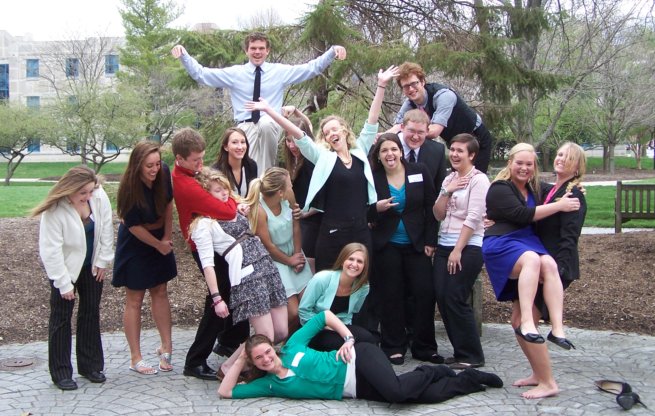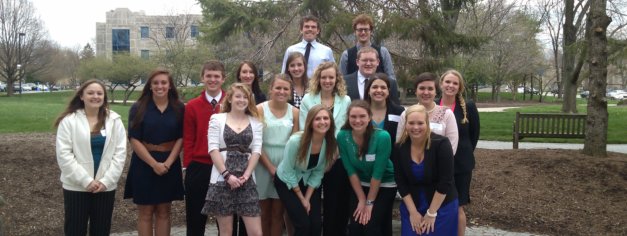
Pictured above from left to right: (Front Row) Erica Bewley, Samantha Nicholas, Marissa Disbrow, Cara Mulhall
(Second RowRow) Michelle Wheeler, Amanda Trambaug, Adnrew Bates, Natlie Morse, Grace Stephenson, Heather Dombrowsly, Katlyn Hogue
(Third Row) Cecelia Fyfe, Sarah Quebe, Jeremy Smith, Cassie Rhemel
(Along the Back) Dan Turnbow, Andrew Snelling
(Not Pictured) Victoria Leedy, Krys Nugent, Courtney Prater
2013 Senior Thesis Projects
Each year the Psychology seniors present their senior thesis work at Butler University’s undergraduate research conference.
Where available, abstracts are printed,
and links to the
PowerPoint Presentations and the
Full paper in PDF form are provided.
Andrew Bates & Michelle Wheeler
The Effects of Team-Building and Personality on Social Loafing.
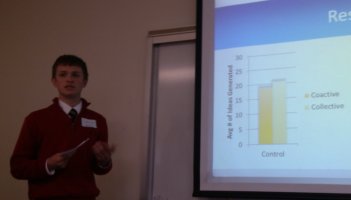
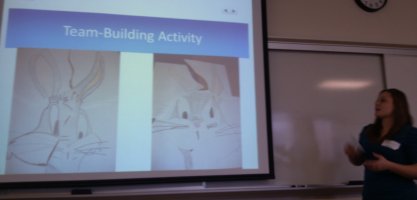 Previous research has shown that individuals often engage in social loafing, or the tendency to exert less effort when working collectively in a group than when working individually. Also, research has shown that several factors may be involved in reducing social loafing, including increasing cohesiveness among the group. The present study examines the effects of team-building activities and personality on social loafing. Participants (N= 38) either completed a team-building activity or a filler task before participating in an idea-generation task where they were given either coactive instructions or collective instructions. Then, the participants completed a Big Five Personality Test and a demographics survey. We predicted that those who participated in the teambuilding activity would be less likely to engage in social loafing, and that team-building will reduce social loafing among extroverts more so than introverts.
Previous research has shown that individuals often engage in social loafing, or the tendency to exert less effort when working collectively in a group than when working individually. Also, research has shown that several factors may be involved in reducing social loafing, including increasing cohesiveness among the group. The present study examines the effects of team-building activities and personality on social loafing. Participants (N= 38) either completed a team-building activity or a filler task before participating in an idea-generation task where they were given either coactive instructions or collective instructions. Then, the participants completed a Big Five Personality Test and a demographics survey. We predicted that those who participated in the teambuilding activity would be less likely to engage in social loafing, and that team-building will reduce social loafing among extroverts more so than introverts.
PowerPoint PDF
Erica Bewley & Daniel Turnbow
Consumers’ Processing of Organic, Natural, and Standard Labeling.
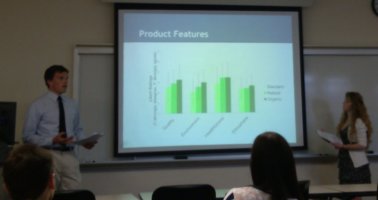 The market for and availability of organic products has expanded drastically in the last decade. Organic products may have a symbolic value on which personality traits can be projected (Grubb & Grathwohl, 1967). Natural products may intend to invoke the same projections often reserved for organic products in order to achieve the same willingness to pay for these products as organic. Participants rated organic products significantly higher than standard products in quality, environmental friendliness, and healthfulness. Participants, however, were unwilling to price organic products significantly higher than standard products. Results also show a relationship between low and high idealism and price willing to pay for the natural and organic products.
The market for and availability of organic products has expanded drastically in the last decade. Organic products may have a symbolic value on which personality traits can be projected (Grubb & Grathwohl, 1967). Natural products may intend to invoke the same projections often reserved for organic products in order to achieve the same willingness to pay for these products as organic. Participants rated organic products significantly higher than standard products in quality, environmental friendliness, and healthfulness. Participants, however, were unwilling to price organic products significantly higher than standard products. Results also show a relationship between low and high idealism and price willing to pay for the natural and organic products.
PowerPoint
PDF
Marissa Disbrow & Katlyn Hogue
Bullying at the Collegiate Level: A Case Study.
People are generally inclined to think about bullying as something that only happens with school children, but we wanted to explore how it might manifest itself in a different setting. This case study was designed to examine the extent to which bullying occurs and how it manifests itself on a particular college campus. Participants were college students ages 18 through 22. They completed an online questionnaire which contained three sections: Witness, victim, and bully. Participants were asked to recount bullying events and indicate the frequency in which they occur in both open-and close-ended questions. We specifically looked at three types of bullying which we labeled as physical, relational, and cyber bullying. We found that there was more reported relational bullying than physical or cyber bullying in both open-ended and closed-ended responses. We hope this provides the groundwork for documenting quantity and the nature of bullying at a particular college.
PowerPoint
PDF
Heather Dombrowsky & Jeremy Smith
Sex Education in Retrospect: Personal Understanding and Comfort Levels.
PowerPoint PDF
Cecelia Fyfe
Maintenance Behaviors in Romantic Relationships.
This study examined the difference in the use of prosocial and antisocial maintenance
strategies used in long distance romantic relationships (LDRs) and geographically close romantic
relationships (GCRs). Participants were recruited from an online survey website. Also, an
additional snowballing sampling method was used to send out the survey link through email.
Only people in current romantic relationships (i.e., people who are married, in committed dating
relationships, engaged, or cohabitating) took the survey. Destructive conflict was negatively
correlated with satisfaction in the LDRs but not the GCRs. Other factors including
understanding, self-disclosure, talks, and networks were correlated to relationship satisfaction in
GCRs. The importance of this research and its implications will be discussed further for
practical and applied purposes.
PowerPoint
PDF
Victoria Leedy & Grace Stephenson
The Effect of Optimism on Physical Illness.
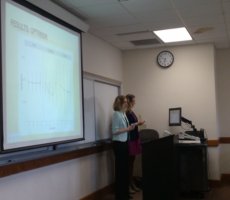
PowerPoint PDF
Natalie Morse and Sarah Quebe
The Effect of Disgust on Moral Behavior.
This study was designed to examine the effect of disgust on moral behavior. Previous research indicates that helping responses are influenced by emotions such as happiness or distress (Lamy, Fischer-Lokou, & Gueguen, 2012). In addition, the emotion of disgust has been shown to increase people’s rating of wrongness of immoral behavior (Wheatley and Haidt, 2005). However, no research has investigated how disgust might go beyond moral judgments to influence moral behaviors such as helping. Participants were placed in one of two conditions: disgust or cleanliness. Two rooms were used, the first for informed consent and debriefing and the second for the conducting of the experiment. In this second room, participants sat in their condition’s corresponding smell and viewed 16 pictures corresponding to their condition (i.e., disgust sat in a bad smelling room viewing disgusting pictures). Each participant completed a survey, rating how clean or disgusting their condition’s room and pictures were on a Likert scale of 1-7. Upon completion, participants were then directed back out to the first room to receive their debriefing and incentive for participation (candy). The first researcher “accidentally” spilled the candy while reaching for the Demographics form and timed how long participants helped pick up the candy. Measured in seconds, we found that participants in the disgust condition helped longer (M=23.85) than participants in the clean condition (M=11.13) because they are trying to rid their feelings of physical disgust.
PowerPoint
PDF
Caroline Mulhall & Cassandra Rehmel
Motivators for Obtaining Advanced Degrees in Today’s Society.
Graduate school involves a significant commitment of time and money and often delays an individual’s entry into the work force. In today’s shifting economy, the reasons for making this choice are likely to be complicated and varied. This study was designed to examine the many possible factors that motivate people to attend graduate school. An online survey was given to current graduate students as well as undergraduates who are thinking about attending graduate school. Specific motivations were measured such as: the desire of learning more about a particular area of academia; potential career advancement; and personal enrichment. Exploratory, open-ended questions were also included. The exploratory method was used to see if there is a difference of motivations between different groups of people, such as gender, and people in different areas of study such as people who are obtaining advanced STEM degrees (i.e., science, technology, engineering and mathematics) compared to those obtaining advanced humanities degrees.
PowerPoint PDF
Samantha Nicholas and Khrystal Nugent
The Effects of Mortality Salience on Decision Making Using a Framing Task.
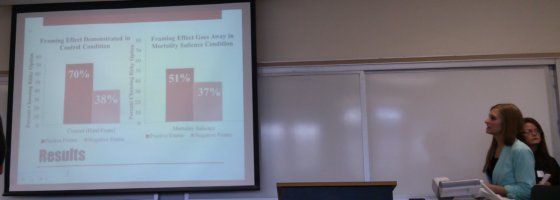 A large body of evidence shows that people’s attitudes and behaviors change when their own death is made salient. However, very little research has examined whether mortality salience is related to decision-making. This is surprising given that emotions have been found to affect decision-making in many contexts. This study was designed to examine the effects of mortality salience on decision-making. Participants (N = 148, 74% female) were randomly assigned to one of two conditions. Participants in the control group were asked a series of questions about their reactions to a difficult exam. Participants in the experimental group were asked a series of questions designed to prime them with thoughts of their own mortality. Then, the participants were directed to the Asian Disease Problem questionnaire, a commonly used measure to assess the likelihood that people will make risky versus certain decisions when a choice is framed negatively versus positively. We used a chi-square analysis to examine how likely people were to choose the risky option in a positive or negative frame. Consistent with prior research on the framing effect, we found that participants in the control group exhibited a significantly higher preference for the risky option in the negative frame condition (70%) than in the positive frame condition (38%), X2(1) = 6.42, p = .01. The framing effect did not emerge in the mortality salience group. That is, participants were no more likely to choose the risky option in the negative frame condition (51%) than in the positive frame condition (37%), X2(1) = 1.78, p = . 18. Indeed, participants in the mortality salience group appeared marginally more risk-averse in the negative frame condition than those in the control group, X2(1) = 2.99, p = .08.
A large body of evidence shows that people’s attitudes and behaviors change when their own death is made salient. However, very little research has examined whether mortality salience is related to decision-making. This is surprising given that emotions have been found to affect decision-making in many contexts. This study was designed to examine the effects of mortality salience on decision-making. Participants (N = 148, 74% female) were randomly assigned to one of two conditions. Participants in the control group were asked a series of questions about their reactions to a difficult exam. Participants in the experimental group were asked a series of questions designed to prime them with thoughts of their own mortality. Then, the participants were directed to the Asian Disease Problem questionnaire, a commonly used measure to assess the likelihood that people will make risky versus certain decisions when a choice is framed negatively versus positively. We used a chi-square analysis to examine how likely people were to choose the risky option in a positive or negative frame. Consistent with prior research on the framing effect, we found that participants in the control group exhibited a significantly higher preference for the risky option in the negative frame condition (70%) than in the positive frame condition (38%), X2(1) = 6.42, p = .01. The framing effect did not emerge in the mortality salience group. That is, participants were no more likely to choose the risky option in the negative frame condition (51%) than in the positive frame condition (37%), X2(1) = 1.78, p = . 18. Indeed, participants in the mortality salience group appeared marginally more risk-averse in the negative frame condition than those in the control group, X2(1) = 2.99, p = .08.
PowerPoint PDF
Andrew Snelling
The Role of Working Memory Capacity on the Effects of Positive & Negative Feedback on Memory Tasks.
It has been observed that people’s performance changes upon the feedback they have received. In particular negative feedback has been shown to improve performance on some tasks. It has been found that this relation can change due to a person’s Working Memory Capacity. The experiment asked participants to perform a digit span memory task to measure their Working Memory Capacity (WMC). Then, they took a free-recall memory test to assess their normal recognition abilities. The free-recall tests measured the percentage of thirty words shown to them that they recognized seeing in a grid of 60 words. After this free-recall test, participants were given feedback on their performance and told it was from the APA database of students who had done the free-recall test in 2010. The feedback was either positive (“Top 20% of others”) or negative (“Bottom 40% of others”), randomly assigned. They were then asked to perform the second, similar free-recall test. The interaction between Feedback and Test Time (F (1, 32) =9.55, p=0.004) showed that those given negative feedback performed slightly better on their second test, and those given positive feedback performed significantly worse on their second test. The possible reasons for this effect are discussed.
PowerPoint PDF
